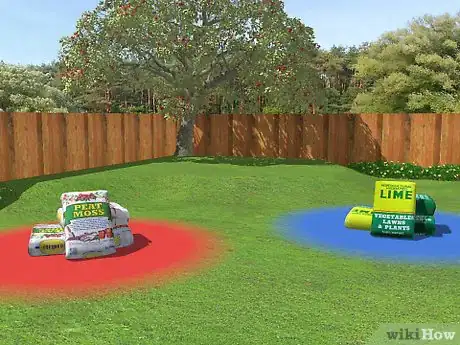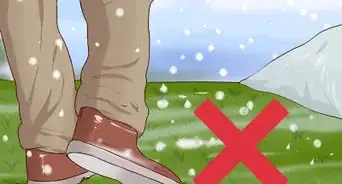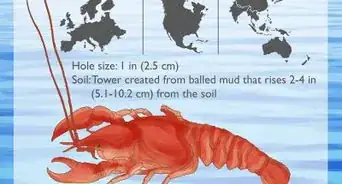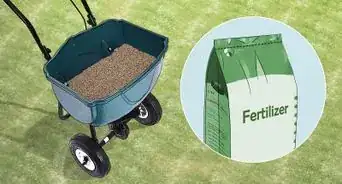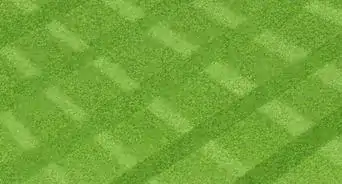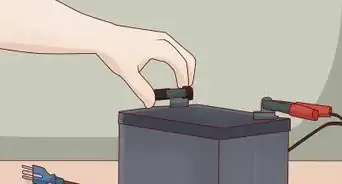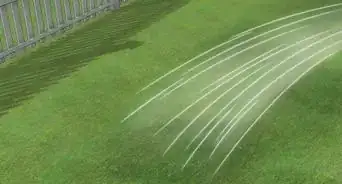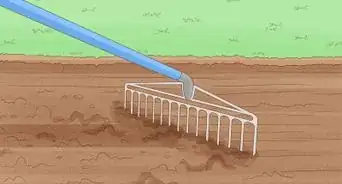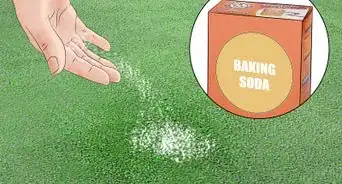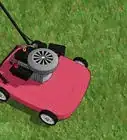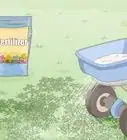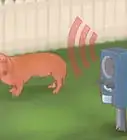This article was co-authored by Ben Barkan. Ben Barkan is a Garden and Landscape Designer and the Owner and Founder of HomeHarvest LLC, an edible landscapes and construction business based in Boston, Massachusetts. Ben has over 12 years of experience working with organic gardening and specializes in designing and building beautiful landscapes with custom construction and creative plant integration. He is a Certified Permaculture Designer, is licensed Construction Supervisor in Massachusetts, and is a Licensed Home Improvement Contractor. He holds an associates degree in Sustainable Agriculture from the University of Massachusetts Amherst.
This article has been viewed 135,649 times.
Is your lawn patchy with spots that are thinning? Fertilizing your lawn can help you get the lush, green grass you desire. To properly fertilize your lawn it's important to prepare the ground, pick out the right fertilizer, and use a method that will give your lawn the best chance to grow in stronger and healthier. Once you've laid out your fertilization plan, try and remain consistent from season to season. With a little work, it truly is easier to keep and maintain a healthy lawn.
Steps
Picking Out Fertilizer
-
1Know your grass. The type of grass you have will determine what type of fertilizer you need to use, and how often you need to fertilize. Some regions have primarily warm season grasses, while others have primarily cool season grasses. If you don't know what type of grass is growing in your yard, ask your neighbors who have similar grass, or take a sample to your local garden center.
- Warm season grasses grow primarily in the southern regions of the US. They include St. Augustine, Bahia, Carpetgrass, Centipede, Bermuda, Zoysia, and Buffalo, among others. These grasses turn brown in the fall after the first frost of the year.
- Cool season grasses grow primarily in the northern regions of the US. They include Fine Fescue, Bluegrass, bentgrass, and ryegrass. Cool season grasses are more cold-tolerant, but will still fade to a light tan or brown color during the coldest winter days in most climates.
- Both warm and cool season grasses can grow in the middle regions of the US.
-
2Do a pH soil test. This measures the alkalinity or acidity of the soil, and helps to determine what pH your fertilizer should have. You can buy pH testing kits for soil at garden stores or online. Follow the instructions on your kit to determine your soil's pH. If your soil has high acidity or alkalinity, you'll need to pick out a fertilizer that will balance things out for optimal growth.
- Take samples from multiple locations and various depths, up to 10 to 12 inches (25–30cm). Record all the results for later reference.
- For more detailed information about your lawn's nutrients, send the soil samples into a soil testing lab or your local agriculture extension.
- If the pH is too low or too high, the nutrients won't be available to the lawn.[1]
- If the soil pH is too low, you may need to add limestone to raise the value.[2]
Advertisement -
3Measure your lawn. You'll need to know the square footage in order to buy the right amount of fertilizer. Multiply the length of your yard by its width to find out the square footage. Make sure you subtract the areas that won't need to be fertilized, like your home and any landscaped areas.[3]
-
4Select a fertilizer that meets your lawn's needs. Now that you know your type of grass and your soil pH, choose a fertilizer that provides the necessary nutrients.
- Fertilizers are always labeled with three distinct numbers, representing these nutrients in this order: nitrogen (N) for leaf growth, phosphorous (P) for development of roots, flowers, seeds & fruit, and potassium (K) for stem growth, water movement in plant, flowering & fruiting.[4] Most lawns do well with a 3:1:2 or 4:1:2 fertilizer.[5]
- If you used a soil testing lab, the report may recommend that you look for a fertilizer or soil addition with extra nutrients. Possibilities include the three macronutrients calcium (Ca), magnesium (Mg) and sulphur (S), as well as the micronutrients copper (Cu), iron (Fe), manganese, (Mn), molybdenum (Mo), zinc (Zn), boron (B). Occasionally specialized plants or soil conditions will require silicon (Si), cobalt (Co), vanadium (V), or other rare mineral catalysts.
EXPERT TIPJeremy Yamaguchi is a Lawn Care Specialist and the Founder/CEO of Lawn Love, a digital marketplace for lawn care and gardening services. Jeremy provides instant satellite quotes and can coordinate service from a smartphone or web browser. The company has raised funding from notable investors like Y Combinator, Joe Montana, Alexis Ohanian, Barbara Corcoran and others.Lawn Care Specialist
 Jeremy Yamaguchi
Jeremy Yamaguchi
Lawn Care SpecialistKnow why you want to fertilize your lawn. Do you want more growth? Do you need to replenish missing nutrients? Your answer helps guide you in what type of fertilizer to purchase.
-
5Choose a type of fertilizer. Even once you here are a lot of different types of fertilizer to choose from, and it's good to do a little research before picking one. Ask for help at your garden store if you have trouble deciding. Here are some factors to keep in mind:[6]
- You can get either liquid or granular fertilizer. Liquid fertilizers work quickly, but they're also absorbed quickly so they need to be reapplied every few weeks. Granular fertilizers are sprinkled across the lawn and get absorbed more slowly.
- Choose between quick release and slow release granular fertilizers. Slow release fertilizers only need to be applied once or twice in a growing season.
- Choose between chemical or organic fertilizer. You can get fertilizer that also kills weeds, but using an organic fertilizer is better for your lawn's health in the long term.
Fertilizing Your Lawn
-
1Obtain the proper equipment. The equipment you use can make a difference in the results of your lawn fertilization. If you have a large lawn, you might need to buy or rent equipment designed to evenly spread fertilizer throughout your yard.[7]
- Choose a rotary spreader for larger lawns.
- Pick a drop spreader for smaller lawns or for lawns with areas that need precise fertilizing, such as around flower beds and landscaping.
-
2Fertilize at the right time of year. In order to your fertilizer to work best, you'll need to time it so that you fertilize at the beginning of the growing season.[8] This is different for different types of grasses.
- Fertilize warm season grasses when the grass begins to turn green at the beginning of spring. Fertilize the lawn again just after the hottest part of the summer is over.
- Fertilize cool season grasses after the heat of the summer is over, since their growing season gets under way in early fall. You can use a Winterizer fertilizer toward the end of the summer to protect the grass over the fall and winter. Fertilize again early in the spring, making sure the fertilizer is timed to be used up before the hot summer weather begins.
-
3Prepare the spreader. Open and close your spreader while it is empty to ensure that it works properly. Fill the spreader with the appropriate fertilizer for the time of year and needs of your lawn. Check the packaging to see the recommended amount. Adjust the spreader so the release of fertilizer matches the recommended dosage on the fertilizer bag.
-
4Start fertilizing. Choose a place in your yard to begin and open the mechanism on the spreader. Walk at a normal pace while spraying the fertilizer. Remain as constant as possible without stopping, slowing or speeding your pace or turning off the spreader.
- Cover your entire yard with the fertilizer. Be cautious about not overlapping or skipping areas.
- Be sure not to spread too much fertilizer. Your yard could experience chemical burn if you aren't careful.
- Clean your spreader when you're finished. Spray the inside and the outside of the spreader with a water hose.
-
5Water your lawn. This helps the soil absorb the fertilizer so your lawn will begin seeing its benefits right away.[9]
Expert Q&A
-
QuestionCan I fertilize and plant grass seed on the same day?
 Anthony "TC" WilliamsAnthony "TC" Williams is a Professional Landscaper in Idaho. He is the President and Founder of Aqua Conservation Landscape & Irrigation, an Idaho Registered Landscape Business Entity. With over 21 years of landscaping experience, TC has worked on projects such as the Idaho Botanical Garden in Boise, Idaho. He is a Idaho Registered Contractor and a previously Licensed Irrigator in the State of Texas.
Anthony "TC" WilliamsAnthony "TC" Williams is a Professional Landscaper in Idaho. He is the President and Founder of Aqua Conservation Landscape & Irrigation, an Idaho Registered Landscape Business Entity. With over 21 years of landscaping experience, TC has worked on projects such as the Idaho Botanical Garden in Boise, Idaho. He is a Idaho Registered Contractor and a previously Licensed Irrigator in the State of Texas.
Experienced Landscaper You can fertilize and plant grass seed on the same day, but only by using a 'Starter' fertilizer blend.
You can fertilize and plant grass seed on the same day, but only by using a 'Starter' fertilizer blend. -
QuestionDo I lime the grass at the same time I fertilize?
 Anthony "TC" WilliamsAnthony "TC" Williams is a Professional Landscaper in Idaho. He is the President and Founder of Aqua Conservation Landscape & Irrigation, an Idaho Registered Landscape Business Entity. With over 21 years of landscaping experience, TC has worked on projects such as the Idaho Botanical Garden in Boise, Idaho. He is a Idaho Registered Contractor and a previously Licensed Irrigator in the State of Texas.
Anthony "TC" WilliamsAnthony "TC" Williams is a Professional Landscaper in Idaho. He is the President and Founder of Aqua Conservation Landscape & Irrigation, an Idaho Registered Landscape Business Entity. With over 21 years of landscaping experience, TC has worked on projects such as the Idaho Botanical Garden in Boise, Idaho. He is a Idaho Registered Contractor and a previously Licensed Irrigator in the State of Texas.
Experienced Landscaper Typically lime is applied at time of aeration.
Typically lime is applied at time of aeration. -
QuestionShould I mow the lawn before I spread fertilizer?
 Community AnswerYes. You should because that will help the fertilize soak into the grass.
Community AnswerYes. You should because that will help the fertilize soak into the grass.
Warnings
- Be careful about choosing a location when cleaning your spreader. You do not want to wash excess fertilizer onto an area of your lawn. Choose your driveway, rocks or concrete for the cleaning.⧼thumbs_response⧽
Things You'll Need
- Fertilizer spreader
- Fertilizer
- Water hose
- Water
- Protective eyewear
- Gloves
- Respirator mask (if desired)
- Long sleeve shirt, full trousers, and covered footwear
References
- ↑ Ben Barkan. Garden & Landscape Designer. Expert Interview. 14 April 2020.
- ↑ Ben Barkan. Garden & Landscape Designer. Expert Interview. 14 April 2020.
- ↑ https://mda.maryland.gov/SiteAssets/Pages/fertilizer/HowToFertilizeYourLawn.pdf
- ↑ Ben Barkan. Garden & Landscape Designer. Expert Interview. 14 April 2020.
- ↑ http://extension.illinois.edu/lawntalk/planting/choosing_fertilizers_for_home_lawns.cfm
- ↑ https://extension.unh.edu/resource/fertilizing-lawn-video
- ↑ https://www.popularmechanics.com/home/lawn-garden/how-to/g237/the-quick-and-easy-guide-to-fertilizing-your-lawn/
- ↑ Ben Barkan. Garden & Landscape Designer. Expert Interview. 14 April 2020.
- ↑ https://www.popularmechanics.com/home/lawn-garden/how-to/g237/the-quick-and-easy-guide-to-fertilizing-your-lawn/
About This Article
If you need to fertilize your lawn, choose a fertilizer that’s right for your grass and the pH needs of your soil. If you have a smaller lawn, fill a drop spreader with your fertilizer, then push the spreader as you walk steadily across your yard. If you have a large lawn, you may need to buy or rent a rotary spreader. Be sure to cover all of your grass, and try not to stop, change your pace, or overlap any areas. When you’re finished, water your lawn to help the soil absorb the fertilizer. Keep reading for more tips from our Landscaping co-author on how to choose fertilizer, including how to test your soil pH!

